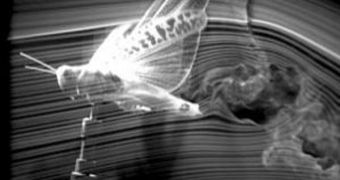One of the most arduous dreams that spies and secret agencies around the world have is to benefit from invisible observers in all possible situations. One way this can be done, and that, apparently, will become reality fairly soon, is through small, insect-like robots, outfitted with small-scale observation equipment. In order to make these instruments a reality, experts have recently constructed a locust simulator, which they hope will provide sufficient answers to the obstacles that lie ahead.
The new simulator will have to take on the big role of assessing precisely how various wing textures influence flight, and also how the wings bend and compress while flapping. The model will also have to determine the role that the shape of the wing plays in making each type of flight unique to each insect. The system is made up of a locust, a wind tunnel, and extremely high-speed flash photography. The instruments measure the way air particles flow beneath, over and around the wings, while the small insects fly in the tunnel, NewScientist reports. This method is called 'particle flow velocimetry.'
Using information collected through this method, experts at the Stanford University developed a computer model that accounted for the insects' wing motion. Based on the model, the team then constructed a piece of software that was able to exactly reproduce wing-structure features, veins, and deformations, depending on the researchers' needs. It can also evidence changes in aerodynamic performances that occur every time one of these variables is modified. The work was conducted by SU lead researcher Adrian Thomas. “Imagine sitting in your living room doing aerial combat with radio-controlled dragonflies. Everybody would love that,” he says.
The expert argues that the main benefit the simulator brings to the table is the fact that much of the guesswork will be taken out of future studies. Researchers will no longer have to build rigid-wing models of various insects, and then infer their behavior from watching actual insects fly. They will be instead able to make changes in real time, and observe the differences that occur from all viewpoints.

 14 DAY TRIAL //
14 DAY TRIAL //